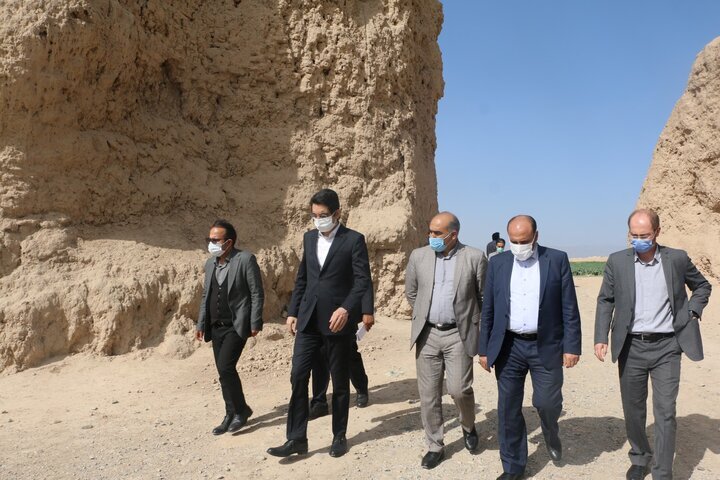Sassanid-era citadel to turn into cultural heritage base

TEHRAN – Qale Iraj, a gigantic mudbrick citadel dating back to Sassanid period (224–651) in southern Tehran, is set to be turned into a national cultural heritage base.
Located in Pishva near the gates of the old city of Rey, southeast of Tehran, the monument (also known as Gabri fort by the locals) was once one of the largest military fortresses of the time.
"Qale Iraj is approved to be turned into the country's 100th base of the national cultural heritage, tourism, and handicrafts," IRNA quoted Pishva's governor, Hossein Abbasi, as saying on Sunday.
The official said that the monument is of high importance as it is one of the largest in the world. "Due to its rich historical and cultural background, Pishva is home to many ancient monuments and sites. And Qaleh Iraj, which is one of the largest brick forts in the world, is expected to date from the Sassanid period (224–651)."
"The bricks used in this castle date back to the Sassanid period and the artifacts discovered from this ancient castle date back to more than 3,000 BC."
"The establishment of this national base will pave the way for the continuous research and archaeological activities on the monument and its surroundings as well as better protection and preservation," he said.
Furthermore, the base is expected to provide the opportunity to study the cultural connection between the Iraj fortress with the surrounding sites inside and outside the city. Moreover, it will pave the way for the preparation of the site for a possible UNESCO registration.
Up to the present not much research has been carried out on this fortress, he noted. "So far, several seasons of documentation and excavation work have been done, which is very limited."
"Various antiquities, the cultural heritage, historical monuments, and arts represent segments of the national identity of the country yet they reflect ancient civilizations, genius, and creativity of our ancestors," the official explained.
Some estimate that the crumbling Iraj fortress dates from the Sassanid era (224–651), however, some experts believe that it belongs to the Kayanian dynasty era, a semi-mythological dynasty, which is mentioned in the Persian poet Ferdowsi’s magnum opus, the Shahnameh.
Measuring about 3,000 square meters in area, the fortress has lost its towers some centuries ago – maybe by erosion, and only lengthy and tall clay ramparts have been left. Based on evidence from excavations in 2008, archaeologists believe that the Iraj fortress was likely abandoned shortly after construction.
Some estimate that the crumbling Iraj fortress dates from the Sassanid era, however, some experts believe that it belongs to the Kayanian dynasty era, a semi-mythological dynasty, which is mentioned in the Persian poet Ferdowsi’s magnum opus, the Shahnameh.
Measuring about 3,000 square meters in area, the fortress has lost its towers some centuries ago – maybe by erosion, and only lengthy and tall clay ramparts have been left. Based on evidence from excavations in 2008, archaeologists believe that the Iraj fortress was likely abandoned shortly after construction.
The history of settlement in Rey dates from the 3rd millennium BC. It is featured in the Avesta (the original document of Zoroastrianism, an Iranian religion) as a sacred place, and it is also mentioned in the book of Tobit, of the biblical Apocrypha, and by classical authors.
According to Encyclopedia Britannica, Rey was one of the capital cities of the Parthian empire (3rd century BC–3rd century CE). It was captured by the Muslim Arabs in 641 CE. During the reign of the Muslim caliph al-Mahdi in the 8th century, the city grew in importance until it was rivaled in western Asia only by Damascus and Baghdad. Islamic writers described it as a city of extraordinary beauty, built largely of fired brick and brilliantly ornamented with blue faience (glazed earthenware). It continued to be an important city and was briefly a capital under the rule of the Seljuqs, but in the 12th century, it was weakened by the fierce quarrels of rival religious sects. In 1220 the city was almost destroyed by the Mongols, and its inhabitants were massacred. Most of the survivors of the massacre moved to nearby Tehran, and the deserted remnants of Rey soon fell into complete ruin.
Rey, however, retains enough history to give it a different sensibility, its key sight is the elaborately decorated Shah Abdol Azim Shrine. Beside the shrine complex is a lively bazaar, while further afield are a couple of minor historical attractions.
AFM
Leave a Comment